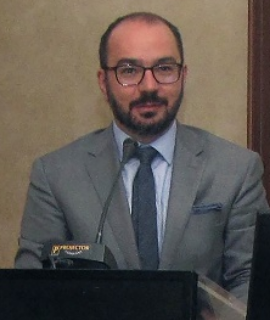About conference
Here is over whelmed to announce its upcoming conference, “3rd International Conference on Bio Printing” which is going to be held in October 23-24, 2023 Los Angeles, USA with the innovative theme “Innovative Approaches For BIO PRINITING”
We cordially welcome all the eminent researchers, students, and delegates to take part in this upcoming ICB-2023 Congress to witness invaluable scientific discussions and contribute to the future innovations in the field of Bio printing.
ICB-2023 will focus on the latest and exciting innovations in all areas polymer research which offers a unique opportunity for investigators across the globe to meet, network, and perceive new scientific innovations. This year’s world congress highlights the theme, “Innovative Approaches Bio printing” which reflects the ground-breaking progress in fetal research.The two days conference include Bio printing workshops, symposiums and special keynote sessions conducted by eminent and renowned speakers who excel in the field of Bio printing which include the topics New Advances in future, advances in Bio printing evaluation and testing. This Bio printing Conference also encourages the active participation of young students, upcoming researchers and budding scientists as we are hosting Poster Award Competition and Young research Forum at the conference venue.
Why to attend
With members from around the world focused on learning about Bio printing and its advances in making a better health; this is your best opportunity to reach the largest assemblage of participants from the Bio printing .Conduct presentations, distribute information, meet with current and potential scientists, make a splash with new Bio developments, new treatment techniques and receive name recognition at this 2-day event. World-renowned speakers, the most recent techniques, developments, and the newest updates in Bio printing are hallmarks of this conference.
Target audience
Bio printing
Acupuncturists
Students & Academicians
Research People
Scientists
Professors
Business Analysts
Scientific Sessions
Track 1: Bio compatible Material
Biocompatibility is related to the geste of biomaterials in colorful surrounds. The term refers to the capability of a material to perform with an applicable host response in a specificsituation.The nebulosity of the term reflects the ongoing development of perceptivity into how biomaterials interact with the mortal body and ultimately how those relations determine the clinical success of a medical device( similar as trendsetter, hipsterism relief or stent). ultramodern medical bias and prostheses are frequently made of further than one material so it might not always be sufficient to talk about the biocompatibility of a specific material. In a simple sense, accoutrements are biocompatible when they ply the anticipated salutary towel response and clinically applicable performance. The other factors of biocompatibility are cytotoxicity, genotoxicity, mutagenicity, carcinogenicity and immunogenicity.
Track 2: Autonomous Self-Assembly
Tone- assembly is a process in which a disordered system of pre-existing factors forms an systematized structure or pattern as a consequence of specific, original relations among the factors themselves, without external direction. There are two types of tone- assembly, intramolecular tone- assembly and intermolecular tone- assembly. Most frequently the term molecular tone- assembly refers to intermolecular tone- assembly, while the intramolecular analog is more generally called folding. tone- assembly is the process in which a system's factors — be it motes, polymers, colloids, or macroscopic patches — organize into ordered and/ or functional structures or patterns as a consequence of specific, original relations among the factors themselves, without external direction.
Track 3: Bio mimicry
Biomimicry is a technological- acquainted approach concentrated on putting nature's assignments into practice. According to Janine Benyus, biomimicry sees nature as A model. It studies nature's models and imitates them or uses them as alleviation for designs or processes with the thing of working mortal problems. The simplest way to describe biomimetic design is that which imitates life. numerous believe that the crossroad of technology and biology is where we'll find alleviation for the future of innovative design. Considered a mix of wisdom and art, biomimicry is invention inspired by nature.
Track 4: 3d Bioprinting Strategies
Thus, one of the most important challenges in 3D bioprinting is to find suitable printing accoutrements with excellent printability, biocompatibility, asked mechanical and declination parcels for towel constructs. Fortunately, due to the advancement of technology, three- dimensional( 3D)- published organs have come a reality. In 2014, a California- grounded company called Organovo was the first to successfully wangle commercially available 3D- bioprinted mortal livers and feathers.3 D bioprinting is anticipated to develop farther beyond structural parallels to functional performance. unborn advancements in 3D bioprinting and affiliated technologies have enormous implicit in the field of towel rejuvenescence, as they will make it possible to regenerate towel in three confines.
Track 5: Extrusion
Extrusion is a process where a material undergoes plastic distortion by the operation of a force causing that material to inflow through an perforation or die. The material adopts thecross-sectional profile of the bones and if the material has suitable parcels, that shape is retained in the final extrudate. A simple illustration of extrusion are the toys used when playing with playdough. The particulars that playdough is pushed through, in order to produce a specific shape, is the bones; and the process is called extrusion. In order for the bones to produce the asked shape, the material needs to be pushed through with force. Extrusion is a manufacturing process that involves forcing base essence through apre-shaped bones to produce objects with a specific shape and profile. As the essence passes through the bones, it's shape changes to reflect the bones's shape.
Track 6: Stereo Litho graphics Based 3d Bioprinting
Development of amulti-material bioprinter for hydrogel stereolithography. SLA is a light- grounded 3D printing fashion that can be used to fabricate both cellular and acellular structures. Stereolithography is a 3D Printing process which uses a computer- controlled moving ray ray,pre-programmed using CAM/ CAD software. Stereolithography( SL) is an artificial 3D printing process used to produce conception models, ornamental- rapid-fire prototypes, and complex corridor with intricate shapes in as presto as 1 day.
Track 7: Bio printed Scaffolds
Three- dimensional bioprinting uses 3D printing ways to fabricate towel, organs, and biomedical corridor that imitate natural towel armature. It combines cells, growth factors, and biomaterials to produce a medium in which cells can grow and separate in towel structures. In 3D bioprinting biomaterials are published subcaste by subcaste to produce structures analogous to a asked organ or towel. The first patent related to this technology was proposed in the United States in 2003 and granted in 2006. Bioprinting involves several way which include opting biomaterial, creating a bioprinting model using CAMs software, printing, and analysis of the published constructs
Track 8: Stereo Lithography
Stereolithography is a 3D Printing process which uses a computer- controlled moving ray ray,pre-programmed using CAM/ CAD software. Stereolithography (SL) is an artificial 3D printing process used to produce conception models, ornamental- rapid-fire prototypes, and complex corridor with intricate shapes in as presto as 1 day. Stereolithography is frequently used for prototyping corridor. For a fairly low price, stereolithography can produce accurate prototypes, indeed of irregular shapes. Businesses can use those prototypes to assess the design of their product or as hype for the final product.
Track 9: Robotic Bio printing Of Organs
Organ bioprinting is the use of 3D- printing technologies to assemble multiple cell types, growth factors and biomaterials in a subcaste- by- subcaste fashion to produce bioartificial organs that immaculately imitate their natural counterparts, according to a 2019 study. At present, 3D bioprinting technologies can be used to successfully publish living apkins and organs, including blood vessels, skin, bones, cartilage, order, heart, and liver. The unique advantages of 3D bioprinting technologies for organ manufacturing have bettered the traditional medical position significantly.
Track 10: Allevi Bio print
The Allevi 2 is a 3D bioprinter by Allevi, a manufacturer from the US preliminarily known as BioBots. According to Allevi, it's the world’s first capitalized desktop 3D bioprinter. This memoir 3D printer has two fixed print heads, which allows druggies to publish two accoutrements during a single print. The first print head has a temperature range of room temperature to 160 °C and boasts a Blue Light( 405 nm) photocrosslinker, while the alternate print head goes up to 70 °C. A UV light is available voluntarily.
Track 11: Extracellular Matrix
The extracellular matrix( ECM) is thenon-cellular element present within all apkins and organs, and provides not only essential physical scaffolding for the cellular ingredients but also initiates pivotal biochemical and biomechanical cues that are needed for towel morphogenesis, isolation and homeostasis. A large network of proteins and other motes that compass, support, and give structure to cells and apkins in the body. The extracellular matrix helps cells attach to, and communicate with, near cells, and plays an important part in cell growth, cell movement, and other cell functions.
Track 12: Synthetic Polymers
Synthetic polymers are deduced from petroleum oil painting, and made by scientists and masterminds. exemplifications of synthetic polymers include nylon, polyethylene, polyester, Teflon, and epoxy resin. Natural polymers do in nature and can be uprooted. They're frequently water- grounded. The polymer called polyethylene is used in plastic bags and film wraps. Polyvinyl chloride( PVC) is used in siding, pipes, and flooring purposes. The synthetic polymer polystyrene is used in closets and in packaging. Polyvinyl acetate is used in bonds and latex maquillages.
Track 13: Bio inks
In bioprinting, a bioink is any natural or synthetic polymer named for its biocompatible factors and favorable rheological parcels. These characteristics temporarily or permanently support living cells to grease their adhesion, proliferation and isolation during development. While a wide variety of accoutrements are used for bioinks, the most popular accoutrements include gelatin methacrylol( GelMA), collagen, poly( ethylene glycol)( cut), Pluronic ®, alginate, and decellularized extracellular matrix( ECM)- grounded accoutrements . The most common natural polymers used in bioprinting are collagen, alginate, hyaluronic acid, and gelatin, as shown in Figure 1 an adaption of( Atala and Yoo, 2015) about a distribution of natural and synthetic polymers employed on bioinks grounded on a compendium from applicable literature.
Track 14: 3d Bioprinting Of Skin And Cardiac Tissues
Adam Feinberg and his platoon have created the first full- size 3D bioprinted mortal heart model using their Freeform Reversible Embedding of Suspended Hydrogels( FRESH) fashion. The model, created from MRI data using a especially erected 3D printer, really mimics the pliantness of cardiac towel and sutures. Recent advances have enabled 3D printing of biocompatible accoutrements , cells and supporting factors into complex 3D functional living apkins. 3D bioprinting is being applied to regenerative drug to address the need for apkins and organs suitable for transplantation. Scaffold grounded 3D bioprinting is used to induce towel constructs using cells, natural macromolecules, and structural halves. The altar- grounded accoutrements have facile face functionalization and superior physicochemical parcels.
Track 15: Reconstructive Surgery
Reconstructive surgery aims to restore normal form and function of towel after it has been compromised by infection, trauma, cancer surgery, or for natural reasons. Rhinoplasty (nose surgery) is an illustration of how it can get confusing to classify a procedure as ornamental surgery or reconstructive surgery. Reconstructive surgery is plastic surgery to help restore form or function to some part of the body due to injury, infection, complaint or excrescence. Reconstructive plastic surgery is also used to correct natural abnormalities (birth blights) and experimental abnormalities.
Market analysis
The global 3D Bio printing market size is projected to reach USD 27980 million by 2026, from USD 8316 million in 2019, at a CAGR of 18.8% during 2020-2030
With industry-standard accuracy in analysis and high data integrity, the report makes a brilliant attempt to unveil key opportunities available in the global 3D Bioprinting market to help players in achieving a strong market position. Buyers of the report can access verified and reliable market forecasts, including those for the overall size of the global 3D Bioprinting market in terms of revenue.
On the whole, the report proves to be an effective tool that players can use to gain a competitive edge over their competitors and ensure lasting success in the global 3D Bioprinting market. All of the findings, data, and information provided in the report are validated and revalidated with the help of trustworthy sources. The analysts who have authored the report took a unique and industry-best research and analysis approach for an in-depth study of the global 3D Bioprinting market.
Global 3D Bioprinting Scope and Market Size:
3D Bioprinting market is segmented by company, region (country), by Type, and by Application. Players, stakeholders, and other participants in the global 3D Bioprinting market will be able to gain the upper hand as they use the report as a powerful resource. The segmental analysis focuses on revenue and forecast by Type and by Application in terms of revenue and forecast for the period 2016-2027

Visa requirements
The ICB-2023 Organizing Committee hereby reiterates that we are NOT involved in VISA processing. We can help you by providing supporting documents such as an invitation letter, abstract acceptance letter, and registration payment receipt.
You may need to submit additional documents along with these documents to the embassy.
Invitation Letter: The official invitation letter is proof that your submitted paper and registration request are accepted by the conference board. It will be indicated in English and can help you with your visa application.
* Only registered participants will receive an official invitation letter
* Participants must complete registration and submit authenticated information to obtain an official invitation letter [i.e. passport (scanned copy), date of birth, mobile phone number, physical address, and a photograph].
*Contact the program manager for more information
• Official invitation letters will be provided only to attend the conference.
** IF YOUR APPLICATION IS TURN DOWN THEN THE ORGANIZING COMMITTEE OF NURSING EDUCATION-2023 CAN NOT CHANGE THE DECISION OF THE DEPARTMENT OF FOREIGN AFFAIRS AND WE WILL NOT HEAR ANY DISCUSSION OR CORRESPONDENCE WITH THE IND, MOFA OR EMBASSY ON BEHALF OF THE CANDIDATE **








